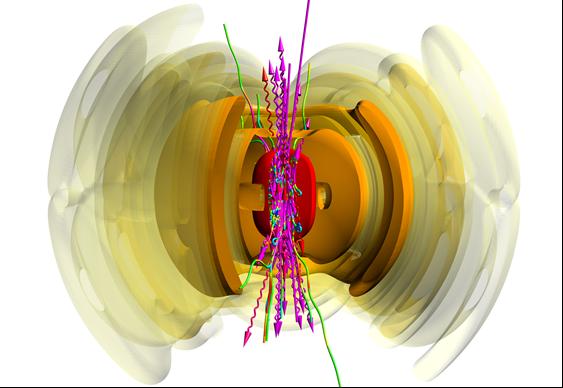Gamma rays will reach beyond the limits of light

Gamma rays are electromagnetic waves, just like visible light or X-rays, but with much higher energy. The most energetic gamma rays in the world could be created by the help of advanced laser physics. When the laser light is intense enough and all parameters are right, trapped particles (green) could efficiently convert the laser energy (surfaces in red, orange and yellow) into cascades of super-high energy photons (pink). Credit: Arkady Gonoskov
“When we exceed the limit of what is currently possible, we can see deeper into the basic elements of nature. We can dive into the deepest part of the atomic nuclei,” says Arkady Gonoskov, researcher at the Department of Physics at Chalmers University of Technology.
The results were recently published in the high impact journal Physical Review X. The new method is an outcome of a collaboration between Chalmers University of Technology in Sweden, Institute of Applied Physics and Lobachevsky University in Russia and University of Plymouth in the UK.
Physicists in different fields, as well as computer scientists, have managed to work out the numerical models and analytic estimates for simulating these ultra-strong gamma rays in a new and somehow unexpected way.
In normal cases, if you shoot a laser pulse at an object, all the particles scatter. But if the laser light is intense enough and all parameters are right, the researchers have found that the particles are instead trapped. They form a cloud where particles of matter and antimatter are created and start to behave in a very special, unusual way.
“The cloud of trapped particles efficiently converts the laser energy into cascades of high energy photons – a phenomena that is very fortunate. It's an amazing thing that the photons from this source can be of such high energy,” says Mattias Marklund, professor at the Department of Physics at Chalmers.
The discovery is highly relevant for the future large scale laser facilities that are under development right now. The most intense light sources on earth will be produced at such research facilities – as big as football fields.
“Our concept is already part of the experimental program proposed for one such facility: Exawatt Center for Extreme Light Studies in Russia. We still don't know where these studies will lead us, but we know that there are yet things to be discovered within nuclear physics, for example new sources of energy. With fundamental studies, you can aim at something and end up discovering something completely different – which is more interesting and important,” says Arkady Gonoskov.
Media Contact
All latest news from the category: Physics and Astronomy
This area deals with the fundamental laws and building blocks of nature and how they interact, the properties and the behavior of matter, and research into space and time and their structures.
innovations-report provides in-depth reports and articles on subjects such as astrophysics, laser technologies, nuclear, quantum, particle and solid-state physics, nanotechnologies, planetary research and findings (Mars, Venus) and developments related to the Hubble Telescope.
Newest articles

Properties of new materials for microchips
… can now be measured well. Reseachers of Delft University of Technology demonstrated measuring performance properties of ultrathin silicon membranes. Making ever smaller and more powerful chips requires new ultrathin…

Floating solar’s potential
… to support sustainable development by addressing climate, water, and energy goals holistically. A new study published this week in Nature Energy raises the potential for floating solar photovoltaics (FPV)…

Skyrmions move at record speeds
… a step towards the computing of the future. An international research team led by scientists from the CNRS1 has discovered that the magnetic nanobubbles2 known as skyrmions can be…





















